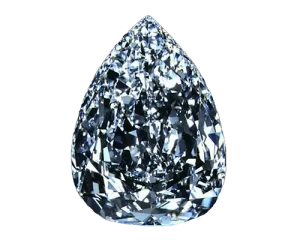
The Great Star of Africa: A Dazzling Tale of History, Controversy, and Unparalleled Brilliance
The allure of the world’s most famous diamonds is a captivating mix of rarity, exquisite beauty, and profound historical importance. Among these celebrated gems, the Cullinan I, more famously known as the Great Star of Africa, stands as a magnificent testament to the sheer power of nature. This colossal diamond, now a central piece of the British Crown Jewels, carries a story as multifaceted as its numerous cuts, a narrative interwoven with discovery, technical mastery, enduring fascination, and colonial controversy.
From Humble Beginnings: The Discovery of a Colossus
The incredible journey of the Great Star of Africa began on January 26, 1905, in the Premier Mine near Pretoria, South Africa. There, mine superintendent Frederick Wells made an astonishing discovery. Embedded in the wall of the mine, sparkling in the late afternoon sun, was the largest gem-quality rough diamond ever unearthed. This immense crystal weighed a staggering 3,106.75 carats ( grams).
The diamond was named Cullinan after Sir Thomas Cullinan, the mine’s owner. Its unprecedented size, combined with its exceptional clarity and bluish-white hue, instantly captured the world’s imagination. Though described as having exceptional purity, the rough stone contained a distinctive internal flaw—a dark spot that would later present a monumental challenge to the expert cutters tasked with its transformation.
A Gift of Empire: From South Africa to the British Monarchy
The fate of the rough Cullinan diamond was sealed by the Transvaal Colony government, which was then under British rule. They decided to present the diamond to King Edward VII as a gift—intended as a gesture of loyalty and reconciliation following the Second Boer War. However, this decision was met with immediate and enduring controversy. Many South Africans believed that the diamond, a natural treasure of their land, should have remained within the country, symbolizing a national inheritance rather than a colonial tribute.
The Cullinan diamond was officially presented to King Edward VII in 1907, who subsequently entrusted its delicate and complex cutting to the renowned Asscher brothers of Amsterdam, widely considered the world’s most skilled diamond cutters.
The Art of Cleaving: Transforming a Giant
The task of cleaving the colossal Cullinan diamond was monumental, demanding months of meticulous study and planning. Joseph Asscher, the head of the firm, painstakingly mapped the stone’s internal structure, searching for the optimal cleaving points that would maximize the quality and size of the resultant gems while mitigating the internal flaw.
The initial cleaving, a moment of extraordinary tension, was executed on February 10, 1908. Asscher positioned a custom-made steel blade against the diamond and struck it with a single, heavy blow. The force of the strike was legendary; while the blade broke, the diamond also split exactly along the intended line. The rough diamond was then further expertly cut into nine major stones and numerous smaller fragments. These nine masterworks were numbered Cullinan I through IX.
The Great Star of Africa: A Crown Jewel of Unmatched Brilliance
The largest of these nine pieces, and the primary reason for the original stone’s fame, became the Cullinan I, officially known as the Great Star of Africa. It is a magnificent pear-shaped diamond weighing carats ( grams) and featuring 74 facets. Upon its completion, it claimed the title of the largest polished diamond in the world, a distinction it held for many years.
The Great Star of Africa was set into the British Sovereign’s Sceptre with Cross, making it a key element of the British Crown Jewels. Its unparalleled brilliance and immense size make it a breathtaking focal point of the sceptre, serving as an indelible symbol of royal authority and power.
The other major stones also found important places: Cullinan II (the Lesser Star of Africa, carats) is set into the Imperial State Crown, while Cullinan III ( carats) and Cullinan IV ( carats) are often worn as private royal pendants.
The Controversy Continues: A Call for Repatriation
The journey of the Great Star of Africa from a South African mine to the heart of the British Crown Jewels remains a persistent source of debate. In recent years, calls for the diamond’s repatriation have become increasingly vocal, forming part of a wider international movement demanding the return of colonial-era artifacts.
Many South Africans argue that the diamond is a potent symbol of colonial exploitation and that it rightfully belongs to the people of South Africa. They view its return as a powerful and necessary gesture of reconciliation, and a vital recognition of the country’s cultural heritage. The debate surrounding the Cullinan diamond raises complex and enduring questions about ownership, historical justice, and the deep-seated legacy of colonialism, highlighting the ongoing global struggle to address historical power imbalances.
